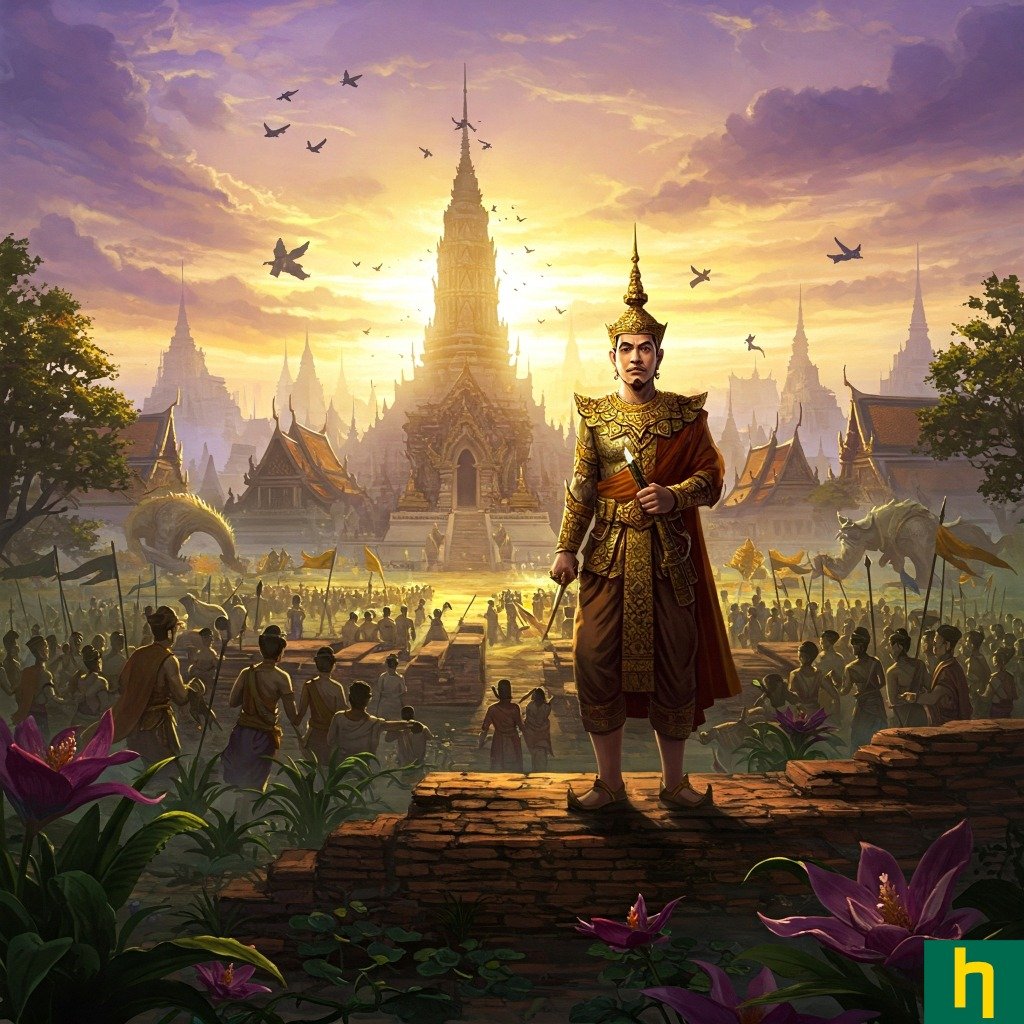The Ayutthaya Kingdom once rivalled the grandest cities of Europe. It was an era that saw waterways teeming with Chinese junks and galleons bearing merchants from Portugal. Europeans who visited would marvel at the Ayutthaya Kingdom’s palaces and countless temples.
The kingdom may have faded away into Thailand’s proud history. But for heritage lovers, wandering the UNESCO-protected Historical Park feels like an open-air museum. Chedis pierce the skyline, and intricate carvings can still be made out despite the march of time.
Live in Thailand long enough, and you’ll be made aware of the popularity of Thai period dramas set during the Ayutthaya period. These plots all revolve around palace intrigue and the dramatic clash of empires. These plots, so loved by TV fans, are not too far apart from real life in the Ayutthaya Kingdom.
The Dawn of the Ayutthaya Kingdom
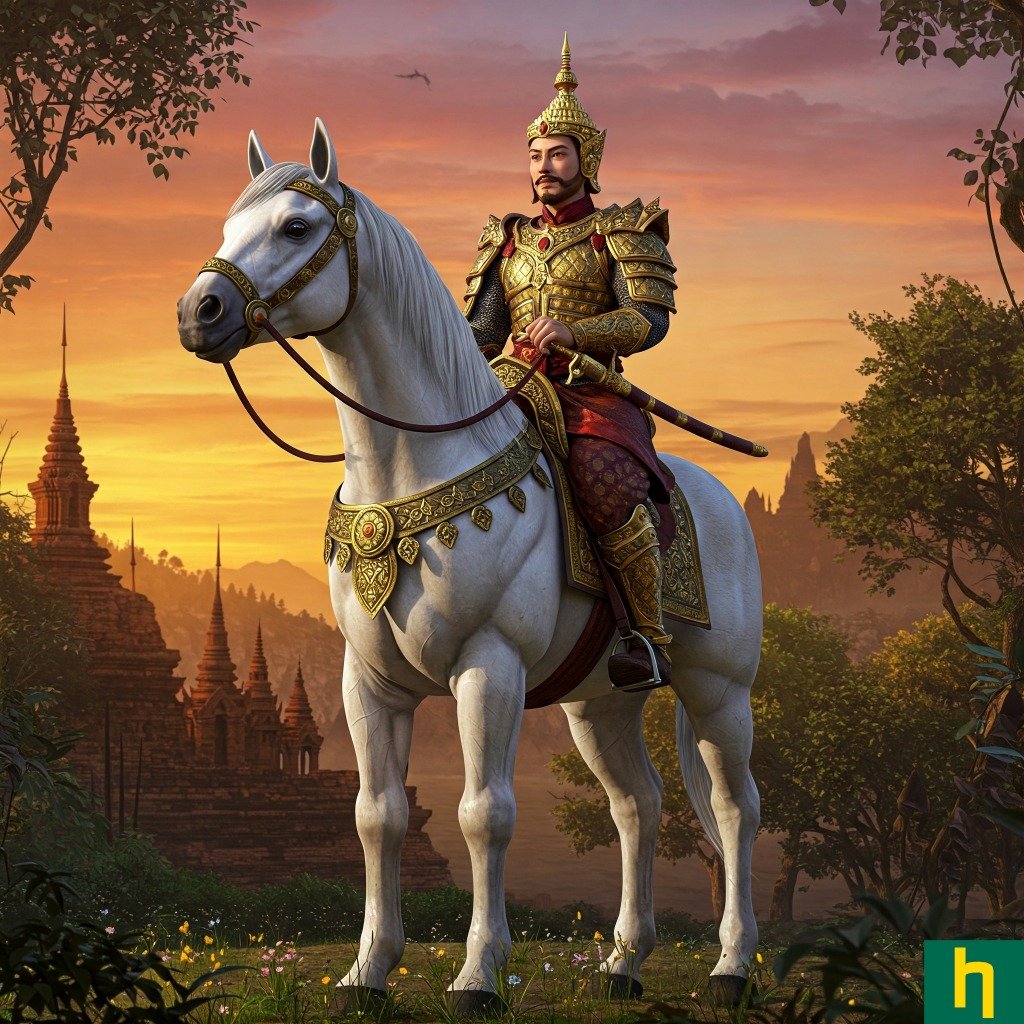
The year is 1351. Three rivers – the Chao Phraya, the Pa Sak, and the Lopburi – converge in the spot that is to become Ayutthaya. It was here that Prince U Thong recognised the potential of this fertile delta. The land was defensible and crisscrossed by natural waterways ideal for both trade and irrigation. Prince U Thong declared the establishment of Krung Thep Dvaravati Sri Ayutthaya – the “Magnificent City of God, Ayutthaya.”
The name itself, which was taken from the mythical city of Ayodhya from the Hindu epic Ramayana, was no accident. It was a deliberate invocation of divine kingship. The early city was a blend of Khmer empire architecture and Siamese aesthetic that was beginning to bloom.
There was a slow absorption of the weakening Sukhothai kingdom. Envoys travelled between the two capitals, negotiating terms, forging ties, and ultimately, seeing the smaller kingdom gracefully folded into that of Ayutthaya. Just like in those Thai period dramas that are so popular.
However, it wasn’t always brute force that was used. Ayutthaya’s vision of a unified Siamese realm was a mighty draw. The early kings, like King Ramathibodi, were nation-builders, laying the foundations for centuries of prosperity and Thai cultural flourishing.
Ayutthaya Kingdom Golden Age
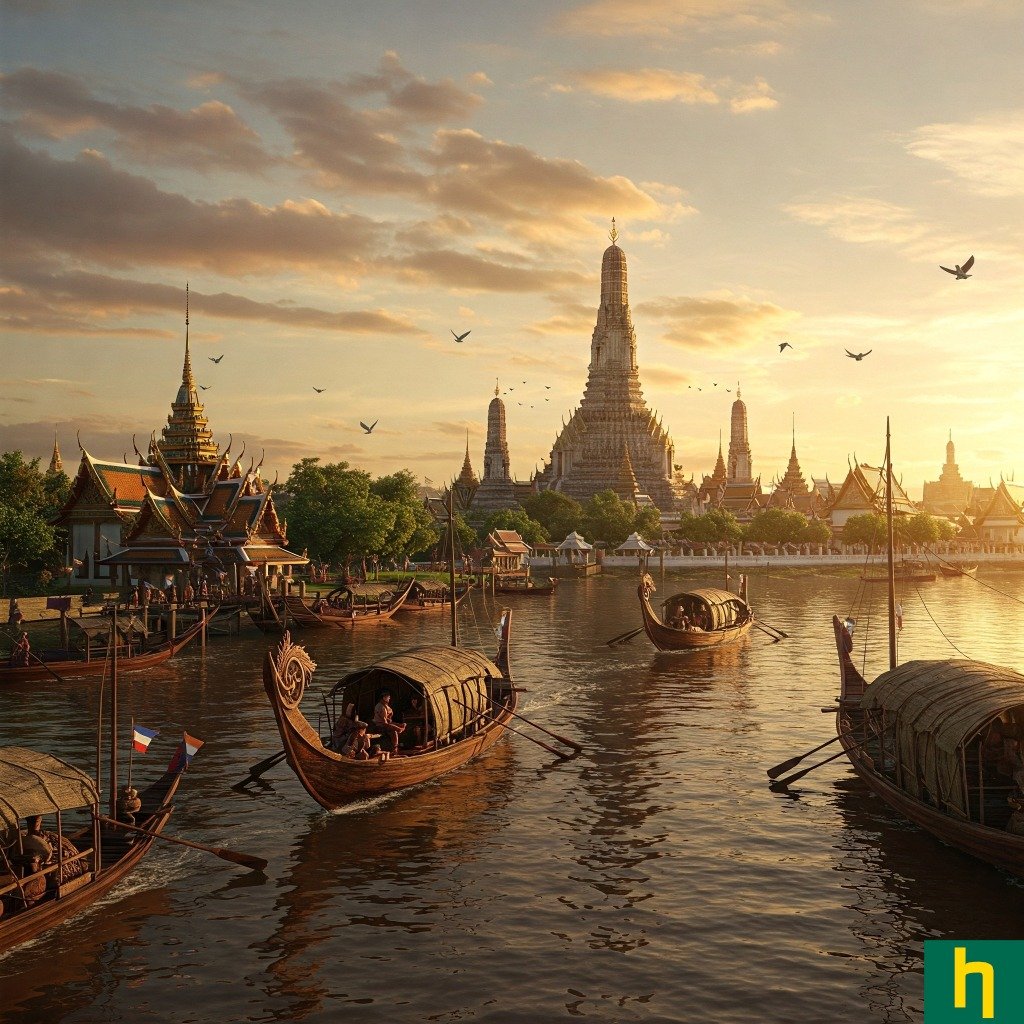
The Ayutthaya Kingdom in the 17th and 18th centuries was prosperous and cosmopolitan. It was a period of stability where Ayutthaya truly blossomed into the jewel of Southeast Asia.
The Chao Phraya River was no longer just a waterway, but a busy artery of international trade. Junks from Canton and Nagasaki competed for space with the galleons of the Dutch East India Company and the Portuguese. Ayutthaya was fast becoming the Venice of the East.
In the court of King Narai, the arrival of the flamboyant Chevalier de Chaumont, the French ambassador, sought to ally with this distant kingdom. Ayutthaya was a melting pot, a place where East truly met West. Each foreign quarter was a microcosm of its distant land.
This Golden Age wasn’t solely about wealth, however; it was about the arts, literature, and diplomacy. Ayutthaya, for a time, was a beacon of power and sophistication in Asia. It was a time when old Siam truly shone.
The Decline and Fall
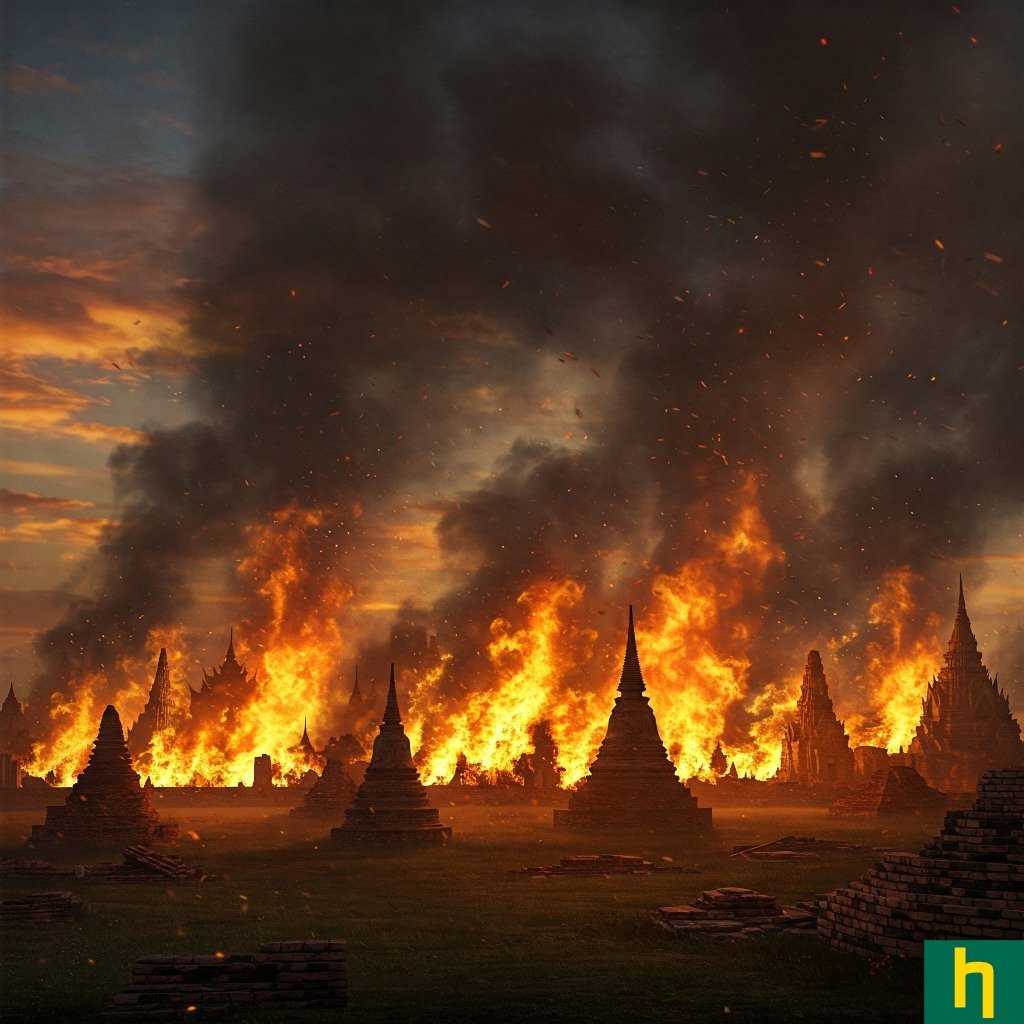
The splendour of Ayutthaya slowly began to fade. The air, once thick with the promise of prosperity, slowly turned to discontent. Internal fissures began to appear within the Siamese court – the web of alliances began to fray, leading to weakened leadership. The focus shifted from the outward gaze of international trade and diplomacy to internal power struggles.
If this wasn’t enough, the ominous presence from the west grew more menacing: the Burmese. The highly disciplined Burmese army pressed against Thai borders, with incursions becoming more frequent. Buffer states began to crumble, leaving the Ayutthaya Kingdom vulnerable.
Sieges were protracted events. Markets went quiet, and once busy waterways became less crowded as trade dried up. The shimmering golden temples, once, were now potential targets.
The final act, in 1767, was an epic tragedy. The Burmese forces, after a long and brutal siege, breached the city’s defences. They immediately set about systematically dismantling the kingdom. The once-glorious palaces were put to the torch, the sacred temples ransacked for treasures, and Ayutthayan society was torn apart forever. There was a desperate grab to save precious artifacts, but most were lost in the flames. The once-glittering city was reduced to nothing more than smouldering ruins.
The shift of the capital to Thonburi marked the end of an era. A city that had stood for over four centuries was left as a reminder of the impermanence of all empires.
Ayutthaya Kingdom UNESCO World Heritage Status
In 1991, a global acknowledgment of its historical and cultural significance was made. UNESCO, the United Nations’ cultural guardian, bestowed upon Ayutthaya coveted World Heritage status.
It was a symbolic declaration that Ayutthaya was no longer a forgotten ruin, but a treasure for all of humanity. For historians and conservationists, it was validation of their efforts to preserve the remnants of the Ayutthaya kingdom.
The UNESCO designation unlocked a new chapter in Ayutthaya’s story, one of careful preservation. And for the locals, there was a deeper understanding of the heritage of their hometown. The UNESCO recognition has become a way to share Ayutthaya’s story with the rest of the world.
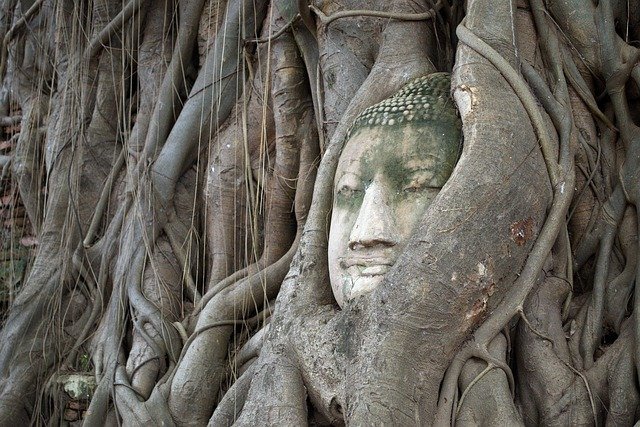
Major Historical Sites of Phra Nakhon Si Ayutthaya
Wat Phra Si Sanphet
Standing before the skeletal grandeur of Wat Phra Si Sanphet, three iconic chedis soar towards the Thai sky. This was the spiritual heart of the kingdom. European visitors at the time likened this place to the great cathedrals of Europe. Now in ruin, the sheer scale of the place still evokes a sense of awe.
Wat Yai Chaimongkol
The silhouette of Wat Yai Chaimongkol’s chedi dominates the horizon. Warrior King Naresuan the Great commissioned its construction to commemorate victory over the Burmese. Climb the steep steps to its upper terraces, and you can imagine the panoramic views.
Wat Ratchaburana
Stepping into Wat Ratchaburana, you can see its distinctive Khmer-style prang. Descending into its crypt, discover its chambers adorned with remarkably preserved murals from the life and times of the Buddha. These artworks show us the artistic sophistication of the era. Local traditions here blended with Khmer aesthetics.
Wat Mahathat
Behold one of Ayutthaya’s most iconic and deeply photographed sights: the serene stone head of the Buddha gently cradled within the sinuous roots of an ancient banyan tree at Wat Mahathat. The relentless growth of nature intertwines with the sacred. The exact origin of this captivating image remains shrouded in a touch of mystery. But the timelessness it evokes is undeniable. Visitors from around the globe stand in contemplation before this evocative tableau. Exploring these sites is not just sightseeing; it’s a pilgrimage into the very heart of the old Ayutthaya Kingdom.
Ayutthaya Historical Study Centre
In the halls of the Ayutthaya Historical Study Centre, the shelves are lined with ancient pottery shards, gleaming bronze artifacts, and fragments of once-colourful murals. It’s a museum where history is actively being explored and interpreted. Groundbreaking discoveries have been made here, revealing new insights into Ayutthaya’s trade networks, social structures, and artistry.
Chao Sam Phraya National Museum: A Royal Treasury Unveiled
The Chao Sam Phraya National Museum is a repository of treasures unearthed from the very soil of Ayutthaya: gold jewellery worn by royalty, carvings on ceremonial weapons, and ceramics traded from distant lands. This museum offers a glimpse into the lifestyle of the kingdom’s ruling elite. It’s a chance to connect with the stories of the skilled artisans who crafted them, the royal hands that once held them, and the historical events they witnessed.
Chandra Kasem National Museum
In the grounds of Chandra Kasem Royal Palace, now a museum, you can imagine the life within the walls of this royal residence. Audience halls where kings received guests, private chambers where royals resided, and the gardens that were once a tranquil escape. This museum provides a perspective on Ayutthayan court life: royal intrigues, artistic patronage, and the daily rituals of the Ayutthayan people.
These museums and study centres are vital institutions that preserve the heritage of Ayutthaya. For us heritage lovers, they’re a crucial complement to exploring the ruins. They provide us with context, understanding, and a deeper appreciation for the kingdom’s history.
Experiencing Ayutthaya
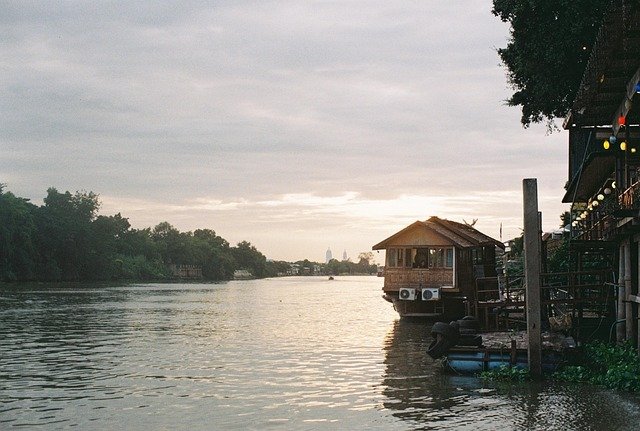
To absorb the spirit of Ayutthaya, you must move beyond simply observing the stones. By immersing yourself in the landscape, you allow the past to resonate through your multi-sensory experience:
Walking and Biking Through Time
Try exploring on foot or perhaps on a leisurely bicycle. This isn’t a rushed tour bus experience; it’s your journey through the Historical Park. This slow exploration allows for moments of quiet contemplation, a chance to truly connect with the soul of Ayutthaya.
River Cruises: A Royal Perspective From the Water
Take a traditional longtail boat or river cruise, along the waterways once busy with commerce. Along the river, the ancient city unfolds from a different vantage point. The chedis, silhouetted against the sky, make the perfect photo op. Royal barges of gold once travelled these very same waters. And as the sun dips, it casts a golden glow on the ancient ruins of Ayutthaya. On the river, you’ll gain a sense of the city’s historical significance from the perspective of those who once sailed here.
Night Markets: A Taste of Modern Ayutthaya With Ancient Flavours
As dusk descends, the energy of Ayutthaya’s night markets awakens. Stalls overflow with street food. It’s a sensory immersion into modern Thailand. It’s a chance to mingle with locals and experience the pulse of this charming small city. There are unexpected culinary delights found in these markets, recipes passed down over the generations, perhaps with a hint of Ayutthayan influence. Dishes such as Boat Noodles, and more modern favourites such as Roti Sai Mai. Whatever you decide to eat, the ancient ruins provide the perfect backdrop to this modern scene.
Ayutthaya Today
Experiencing Ayutthaya is to feel the weight of history beneath your feet. It’s hearing the whispers of the past on the breeze, and tasting the flavours of a culture that’s endured centuries. Today, Ayutthaya isn’t merely a relic frozen in time; the ruins of once great Ayutthaya are interwoven with the energy of contemporary Thai life.
The ongoing work of archaeologists ensures the legacy of Ayutthaya lasts. It’s a process of understanding, restoring, and safeguarding the Outstanding Universal Value of Ayutthaya’s UNESCO heritage site.
There’s a deep sense of pride that Ayutthaya holds in the Thai national identity. National holidays and ceremonies are held amidst the ancient temples. But Ayutthaya today is also a place of everyday life. The city has adapted and evolved, its modern infrastructure supporting a community that cherishes its inheritance.
The charm of Ayutthaya lies in its ability to blend the historical with the contemporary. The old Ayutthaya Kingdom may have fallen to the Burmese, but its spirit continues to thrive to this day. It’s a destination offering not just a glimpse into the past, but an experience of the present, deeply rooted in a magnificent heritage.
Ayutthaya Kingdom FAQs
Who founded the Ayutthaya Kingdom and when?
The Ayutthaya Kingdom was founded in 1351 by Prince U Thong, who became known as King Ramathibodi I. He established the capital city, Ayutthaya, at the strategic confluence of three rivers, a location that provided both natural defences and access to international trade routes. The city’s name was a nod to the mythical city of Ayodhya from the Hindu epic Ramayana, symbolising the concept of a divine king.
What was the Golden Age of the Ayutthaya Kingdom like?
The kingdom’s Golden Age occurred during the 17th and 18th centuries. It was a period of immense prosperity and cultural flourishing, with Ayutthaya serving as a cosmopolitan hub of international trade. Merchants from across the globe, including China, Japan, and European powers like the Portuguese and Dutch, flocked to the city. This era saw significant developments in art, literature, and diplomacy, making Ayutthaya a major power in Southeast Asia.
What was the ultimate cause of the fall of Ayutthaya?
The fall of the Ayutthaya Kingdom in 1767 was the result of a combination of internal and external factors. Prolonged internal political strife and a lack of a clear line of succession left the kingdom vulnerable. The final blow came from a Burmese invasion led by the Konbaung dynasty, which laid siege to the capital for 14 months before finally breaching its defences and utterly destroying the city.
What is the legacy of the Ayutthaya Kingdom in modern Thailand?
Despite its destruction, the Ayutthaya Kingdom’s legacy is deeply ingrained in modern Thailand. It is considered the direct precursor to the current nation, with many of its cultural and artistic traditions being carried forward. The architectural style, legal systems, and diplomatic practices of Ayutthaya laid the groundwork for the later Thonburi and Rattanakosin Kingdoms, the latter of which established the current capital in Bangkok, which was deliberately designed to emulate the former glory of Ayutthaya.
How is the historic city of Ayutthaya preserved today?
The ruins of the ancient capital are now protected as the Ayutthaya Historical Park, which was designated a UNESCO World Heritage Site in 1991. The site contains the remains of temples, palaces, and monasteries, serving as a powerful testament to the kingdom’s grandeur. The designation and ongoing restoration efforts by the Thai Fine Arts Department work to preserve the ruins for future generations and make them accessible to tourists and scholars.

